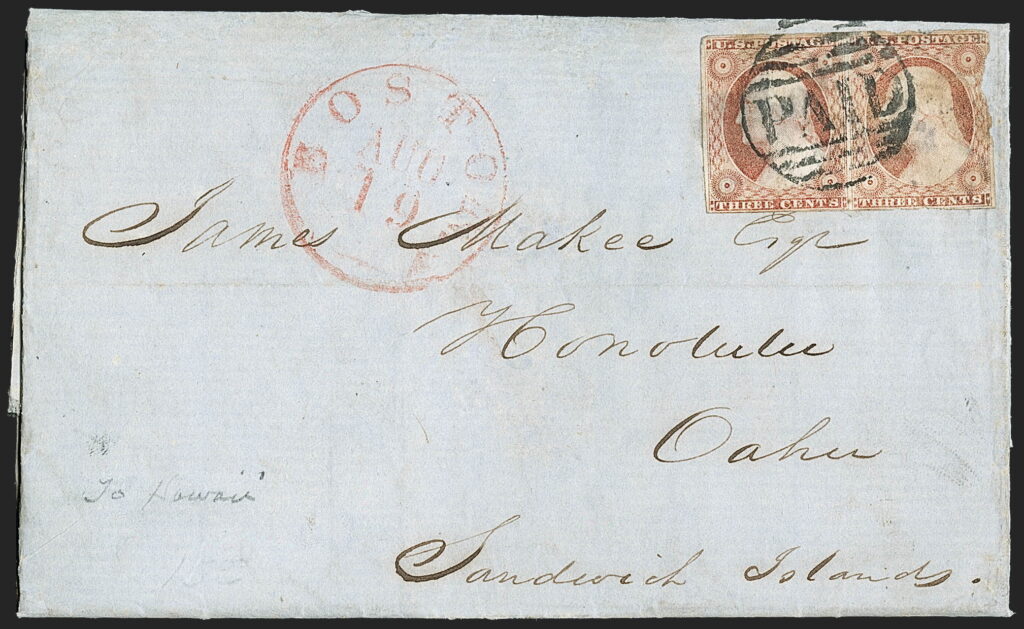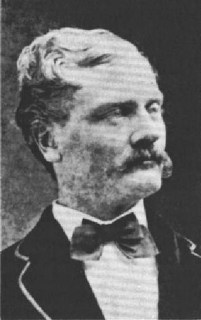James Makee was born at Woburn, MA, November 24, 1812. He married Catherine McNiven in New York in 1836. He first arrived in Hawai‘i in 1843, in command of the sperm whaler Maine, having been compelled to put into this port for medical assistance. (PCA, Sep 20, 1879)
While the Maine lay in the roadstead off Lahaina, Maui, it was learned that her master, Captain James Makee, had been attacked by the ship’s cook, brutally cut with a hatchet or cleaver, and left for dead.
This unfortunate incident, however, resulted in Captain Makee abandoning his seafaring career and he became interested in Hawai‘i and decided to locate in Honolulu, sending for Mrs. Makee, then living in Massachusetts.
Makee, then only thirty-one years of age and founder of the Makee family in Hawai‘i, remained in the islands to become a distinguished pioneer builder, first as a merchant in the whaling industry and later as a rancher and sugar planter.
As a trader in Honolulu, Captain Makee met with success in his first venture and formed the firm of Jones and Makee, ship chandlers, the partnership later becoming Makee, Anthon & Co. The company did a flourishing business and in 1850 Makee, Anthon & Co. were agents for some fifty out of seventy whaling ships in port on October 18 of that year.
The following year marked the first entry of Honolulu men into the whaling industry as ship owners, when Captain Makee, with a group of other local merchants as minority shareholders, acquired the “Chariot” and sent her into the Artic in April, 1851.
With the expansion of business in Honolulu, Captain Makee in 1853 financed the erection of the Makee & Anthon block on Queen Street, the first three-story brick building in Honolulu, materials for which were imported from Boston.
“Something New in Honolulu. A fine new Fire-Proof Store, three stories high, erecting at the corner of Kaahumanu and Queen streets, by Capt. Makee, built of brick, with a granite front, is something new in Honolulu, and consequently excites considerable attention.”
“No granite has before been used in the erection of buildings, at the islands, although fence and gate posts, and a few door-steps, have been imported from China, of a quality, however, far inferior to the Massachusetts granite now used by Capt. Makee, in the construction of his Store. This block will be of the most substantial character, and an ornament to the city.” (Polynesian, April 1, 1854)
Then, a second ship, the bark “Black Warrior,” was acquired by Makee & Anthon, and operated as a whaler for three years.
On January 23, 1856, “Kapena Ki” (Captain James Makee) purchased at auction Torbert’s plantation on Maui. He sold his Nuʻuanu residence and moved to Maui and raised his family on what he called ‘Rose Ranch’ after his wife Catherine’s favorite flower.
The extensive estate had some limited facilities for raising and milling sugar cane and was developed both as a cattle ranch and sugar plantation by Captain Makee.
He took a deep interest in the upbuilding of the property and was one of the first to import thoroughbred stock on a large scale. He also engaged in dairying and in 1858 began planting sugar cane, rehabilitating the abandoned Torbert enterprise.
Makee was one of the first to import, on a large scale, purebred stock. He also went in for dairying and his “sweet butter” found a fine market. In 1858 he began the rehabilitation of Torbert’s cane and the crop of 1861 was marketed in Honolulu.
He solved the area’s major problem – water. “Makee has built a wooden house and deep reservoir on the side of the house. The troubles of the men and women are now ended by this work, they are now truly well supplied with water. This land, in ancient times, was a barren open place, a rocky, scorched land, where water could not be gotten.”
“The water of this land in times before, was from the stumps of the banana trees (pūmaiʻa), and from the leaves of the kākonakona grass; but now there is water where moss can grow. The problem is resolved.” Nupepa Kuokoa, Iulai 7, 1866, [Maly, translator])
“Makee’s Plantation or Rose Ranch, as it is more generally termed by the proprietor and his friends, is situated on the south eastern part of the Island of Maui, in the district of Honuaula. … The estate contains about 6,500 acres, 1,200 of which are capable of producing cane.” (Pacific Commercial Advertiser, September 19, 1861 [Maly])
(From Torbert, then the decades of ownership by Makee, then Dowsett, Raymond and Baldwin, in 1963, the property was acquired by the Erdman family. The property is now known as ʻUlupalakua Ranch and it remains a cattle ranch.)
The sugar crop of 1861 was marketed in Honolulu and by 1862 the plantation had been greatly improved, according to the accounts of Rev. S. C. Damon, who visited Ulupalakua in that year.
During the Civil War Captain Makee won wide attention by a patriotic gift of two consignments of molasses, of one hundred barrels each, which he sent to San Francisco to be sold for the benefit of the Sanitary Commission at Washington, DC.
Later, a shipment of sugar and island produce was sent by Parker N. Makee, a son, as an additional contribution to the Union cause.
Throughout his residence at “Rose Ranch,” Ulupalakua, Captain Makee was noted for his hospitality, visitors from all parts of the world being entertained there.
On July 18, 1871, Colonel Zephaniah Swift Spalding married Makee’s first born daughter, Wilhelmina Harris Makee at McKee’s Rose Ranch in Ulupalakua, Maui. In that same year, Makee’s eldest son, Parker, took over management of the West Maui Sugar Association.
In 1876, Captain Makee and Spalding purchased Ernest Krull’s cattle ranch in Kapa‘a, Kauai, intending to start a sugar plantation and mill. After a brief stay in San Francisco (1875-1878) Spalding returned to the Islands, living on Kauai, where Makee was already operating the Makee Sugar Company and mill at Kapa‘a.
King Kalākaua and others formed a hui (partnership) to raise cane. About the first of August, 1877, members of Hui Kawaihau moved to Kauai. Makee had an agreement to grind their cane.
In 1876, Kapi‘olani Park was initially touted to create “a tract of land in the vicinity of Honolulu as a place of public resort,” where “agricultural and stock exhibitions, and healthful exercise, recreations and amusements” could occur, its literal purpose was far from it.
On the dedication day in 1876, King Kalākaua and James Makee (Kapiʻolani Park Association’s first president) stressed the public space, which they said was needed for a modern city to be civilized, to allow “families, children, and quiet people” to find “refreshment and recreation” in the “kindly influences of nature,” and to be a “place of innocent refreshment.”
However, when Kapiʻolani Park was first conceived, the motivation wasn’t about creating a public place. Kapiʻolani Park began as a development project, run by the Kapiʻolani Park Association.
The association was founded with a two-fold purpose: (1) building residences for its stockholders along the ocean at Waikiki and on the slopes of Diamond Head and (2) laying out a first-class horse-racing track as a focal point of this new suburb. They named the large island in the Park’s waterways after James Makee.
Appointed a commissioner to aid in the development of the resources of the Kingdom of Hawaii in 1877, Captain Makee in that year launched a breakwater project at Makena, Maui, developing a harbor to facilitate the shipment of sugar.
Captain Makee also owned the Waihee Plantation, Maui, of which his son, Parker, was manager. His interests in the Ulupalakua ranch were divided to members of his family in Jan., 1878.
Upon his death in Honolulu, September 16, 1879, Captain Makee was survived by his widow and eight children, Charles and Parker N Makee, Mrs ZS Spalding, Mrs MLW Kitchen, Mrs D Noonan, Mrs George Herbert, Mrs ED Tenney and Mrs FP Hastings. (lots of information here is from Orr.)







